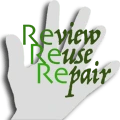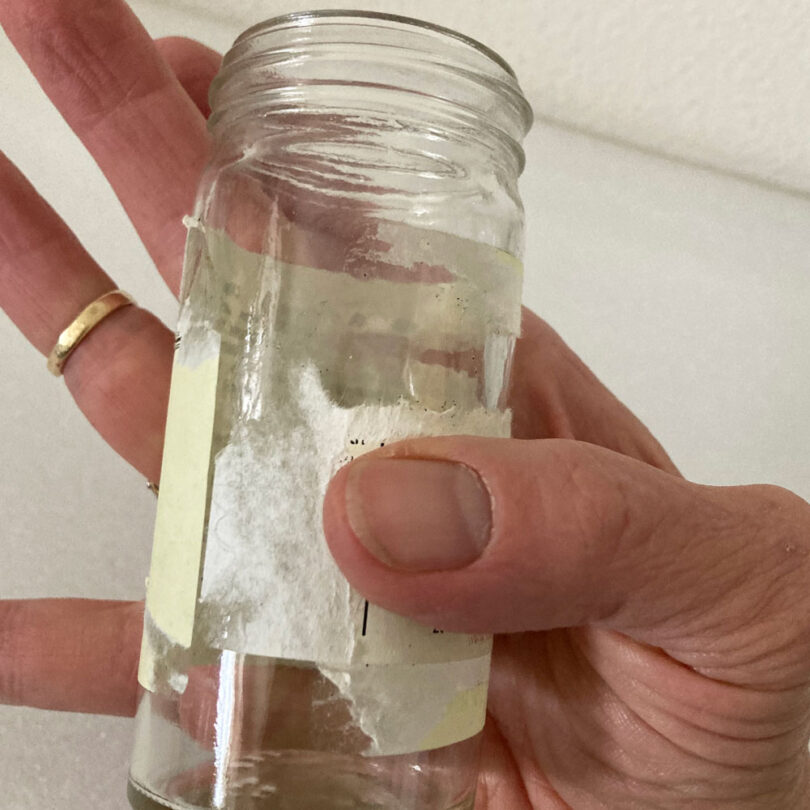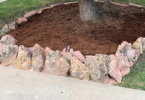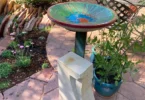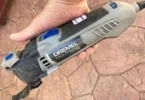Have you ever struggled with how to remove sticky residue from surfaces at home? What is the best way to remove sticky adhesive from a food product label? Have you bought something new and the price tag or informational stickers won’t peel off? How about a bandage? Tape residue – especially that two-sided foam stuff? The answer is:
It Depends!
Mostly the answer is determined by what solvent was used to formulate the adhesive, and we often don’t know that. If you were as bad as I was in Chemistry class, many of the solvent ingredient names sound similar to me and I don’t tend to remember them. I researched each one I mention and try to make your choices clear and easy in my list.
Many of these products for removing adhesive probably are already available in your home. Learn more about what you can use and keep on hand to help with annoying sticky residue problems.
Food Safe Adhesive Removal
I’ve learned to try to use solvents in the order of harshness – starting with the least harsh and working up to whatever ends up working. This is how to remove sticky residue from surfaces in the order I would try the products.
#1 – Water & Soap
I’ve actually been surprised at how well hot water and some dish soap are at removing some adhesives. About half of the food product labels on glass or plastic will come off or at least loosen up if you run them through a dishwasher cycle. Try to pull them out before the drying stage of the dishwasher runs for your best chance to get the label off. Even if you don’t get rid of all of the adhesive, having the label out of the way can help get one of the solvents lower on this list to work more quickly.
If your item is not dishwasher safe, but it can be soaked in water, put hot water & some Dawn Dishwashing liquid in a bucket, a tray or a stoppered sink. Let the item soak until the water cools off, then try to remove the adhesive.
#2 – Vinegar
Vinegar is acetic acid diluted with water. Household White Vinegar tends to be diluted enough that it may not work much better than water. Concentrated Garden vinegar (such as the kind used for natural weed control) may have more of an effect. Other kitchen vinegars like wine vinegars should not be used if they can discolor or dye the surface you are trying to clean.
To apply vinegar, just pour it onto a paper towel, cotton swab or cotton rag, then rub at the adhesive.
#3 – Coconut Oil, Olive Oil or other Vegetable Oil
Rubbing a surface with food safe oil can soften some adhesives, and as the surface cleans up, the oil prevents the adhesive from re-adhering. In my experience, Coconut Oil is the best performing of the oils for adhesive removal, but use Olive Oil, Canola Oil, or whatever you have on hand.
To use oil to remove sticky residue, just soak a piece of cotton rag or a paper towel in the oil, then let it sit on the surface for a while to let the adhesive soften. Then use the oily cloth to work at the edges of the adhesive.
I have had luck using Coconut Oil to remove the adhesive that is left behind when you remove a bandage or medical tape. In this case, just work the Coconut Oil into your skin with your fingers.
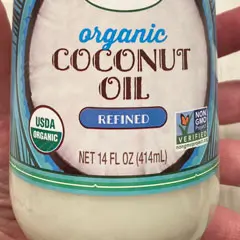
Not only will you probably get rid of the sticky residue, but the Coconut Oil is good for softening and moisturizing your skin. That is why you find it used in many commercially available skin and hair products.
Removing Sticky Adhesive from Fingers
Today I had a project where I ended up with Gorilla Glue Spray Adhesive all over my fingertips and underneath my fingernails. It is really great glue (it deserves it’s own review article) but it was thick and dried on my skin and under my nails. I tried water, Isopropyl Alcohol, and 100% Acetone and nothing helped. Then I thought about using Canola Oil – the adhesive easily started rubbing off my skin and I wiped the dried adhesive and the oil on a paper towel. I also was able to easily scrape the dried glue off of my nails.
#4 – Ethanol
Ethanol is a plant based product. It is the shorter name for ethyl alcohol.
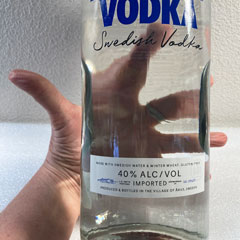
You may have some Ethanol in your liquor cabinet – the best type to use for removing sticky adhesive is Vodka, since it tends to be colorless.
To apply ethanol, just pour it onto a paper towel, cotton swab or cotton rag, then rub at the adhesive.
Skin Safe Adhesive Removal
The solvents described below are not safe to consume, but are considered safe for your skin. How to remove sticky residue from surfaces with these solvents is the same as with food safe items like ethanol: soak the corner of a rag, a paper towel or a cotton swab with the solution and rub at the adhesive.
You may still want to wash your hands with soap & water after using these items, but they are generally considered safe to use on your skin. Always follow the labels on the product package, though.
#5 – Non-Acetone Nail Polish Remover
Commercially available Nail Polish Removers that do not have Acetone as the active ingredient(s) are considered to be pretty gentle on your skin. Their active ingredients vary, but stuff that dissolves nail polish can also do a good job on sticky adhesive residue. These products tend to also have some skin moisturizers and fragrance in them, which is a nice bonus.
Mineral Fusion makes a nail polish remover that contains no Acetone. The active ingredients listed on the package are Methyl Acetate and Isopropyl Myristate.
#6 – Isopropyl Alcohol
Isopropyl Alcohol is safe for your skin – it commonly is used in doctor’s offices, such as when they are preparing to draw blood or give an injection. It also is commonly referred to as ‘Rubbing Alcohol’. Not only is it a solvent but it’s a good germ killer. Many Hand Sanitizer products contain Isopropyl Alcohol. In fact, the US Food & Drug Administration (FDA) allows only two types of active ingredients in Hand Sanitizer – this or Ethanol (mentioned above).
Isopropyl Alcohol is made through chemical manufacturing and is poisonous when consumed. It does make a good solvent, though.
The kind I currently use is 70% by volume, but you can find higher percentages. For dissolving adhesives, anything from 70% and up is fine.
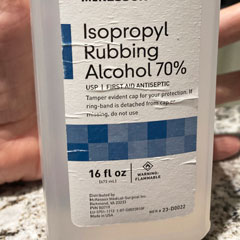
One of my favorite ‘life hacks’ is that it is very good at removing permanent marker from plastic. If you want to re-use a plastic zip bag and need to change the label, Isopropyl Alcohol on a paper towel will quickly dissolve the marker without ruining the bag.
Isopropyl Alcohol is a good solvent for cleaning up epoxy or non-water based glues before they dry. See my information about epoxy cleanup in my article on JB Weld KwikWood.
A common solvent that I use in my DIY projects is Isopropyl Alcohol. It is also good for cleaning sticky debris after peeling off a paper sticker, or getting permanent marker or ink off of a surface like plastic or glass.
#7 – Acetone Nail Polish Remover
While Acetone is the active ingredient in many nail polish removers, the products formulated for removing nail polish have some conditioners to help be a little gentler and less drying for your skin. They also tend to contain some fragrance so that it doesn’t smell as intense.
I have found that the amount of Acetone found in Nail Polish Remover is sufficient to dissolve the sticky adhesives from most labels. The problem is that, depending on the surface underneath the label, you can remove the paint or destroy the surface appearance of the item. Acetone is fine on glass surfaces or surfaces applied with heat (pottery glazes, enameled surfaces), but might disrupt plastic, painted, or stained surfaces.
Acetone is the first ingredient listed on the product label, but this Nail Polish Remover is not 100% Acetone. It contains other ingredients that are intended to make it less drying and better smelling than pure Acetone.
Caution with Acetone: Be aware that acetone can dull the surfaces of certain plastics. If you are cleaning sticky residue from a plastic surface, be sure to test in an area that won’t be noticeable, or consider using Goo Gone (see below) instead.
Instead of using 100% Acetone, if I don’t have any luck with a partial solution of Acetone, I move up to the Petroleum-based products listed below in ‘Strong Solvents’.
Strong Solvents for Resistant Adhesive
The strongest of household solvents are best used while wearing gloves. If that is not possible (you don’t have gloves, are allergic to latex or the powder they put in gloves, or the adhesive is sticking to the gloves) be sure to throughly wash your hands with soap and hot water after you are done with these.
As mentioned earlier in this article, I use these only when nothing else works. They also tend to be be fairly stinky. Pour these products only onto something you plan to throw in the outdoor trash receptacle when you are done: a piece of old rag, a paper towel, a cotton swab or pad. I also try to use them outdoors, or with very good ventilation.
#8 – Goo Gone
I have used the Goo Gone product for many years, and sometimes, it is the only thing that will cut through tough adhesives, such as duct tape residue. I looked up what is in it: Goo Gone has seven ingredients, four of which are solvents (in order of volume):
Petroleum distillates, Aliphatic ether alcohol, d-Limonene, and Orange sweet extract
The other three ingredients are a thickener (helps it from running off) and two fragrances (to help with the odor).
An 8 ounce bottle of Goo Gone like this one always last me a long time. You don't need very much as it is very effective at dissolving sticky labels or tough jobs like removal of tar on your car.
#9 – Mineral Spirits
Mineral Spirits is a pretty name for 100% Petroleum distillates. As I was preparing the information in this article, I was reminded that back in ‘olden times’ my dad would just pour gasoline on an old rag and use it to clean greasy tools or engine parts. I can assure you that protective gloves were ‘not a thing’ at that time for DIY activities. Mineral Spirits at least smells a little better! Please do use gloves when handling it.
Mineral Spirits are the active ingredient in Paint Thinner. It can dissolve dried paint off of a surface, so also be careful what items you use it on. Surfaces where I have successfully used Mineral Spirits include glass, high Fire glazes on Ceramics, paint that has been cured with heat, epoxy based paint (such as the white finish on Elfa Storage Racks).
I like the Klean Strip brand of mineral spirits, because they manufacture it in a way that it smells less bad than others. The can says both "odorless" and "ultra low odor" - but I am so sensitive to odors that I'll stick with "less stinky". This link will take you to the 1 quart size container.
Bonus Solvent – WD40
If you don’t have Goo Gone or Mineral Spirits on hand, you may have another thing that you didn’t even know that works as a solvent: WD40! Most people think of WD40 for lubricating sticky or rusty parts, but one of the main ingredients is Petroleum base oil.
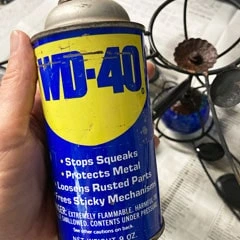
While reviving this garden whirligig with WD-40, I was reminded that it works not only to lubricate and protect metal, but it functions as a solvent for certain sticky adhesives.
Other Ideas for How to Remove Sticky Residue from Surfaces that you Can’t Get Wet
Sometimes, the solution is mechanical instead of chemical. Here are some ideas for how to remove sticky residue when you can’t put solvents or even water on your item:
- Put the item in the freezer – when frozen, sometime you can pop the sticky stuff off. This works well with chewing gum.
- Sometimes a pencil eraser will rub adhesive off of a surface that you can’t get wet, such as drywall – either unpainted or with a matte/flat painted surface.
- I have fairly good fingernails, and I don’t mind using them as tools, but a putty knife or dull single-edge razor blade can be useful when trying to remove that foam two-sided tape adhesive. Tools with a thin smooth edge can help you lift the edge so that you can peel bits of the adhesive off.
- Heat up the sticky area with a hair dryer – some adhesives can be easier to remove when they are warm. Discontinue this though, if it seems like your adhesive is getting more sticky.
A Final Comment
In case you were wondering about that spice jar that I show in my featured image, that label was very stubborn. Even after peeling as much of the label as I could and running it through the dishwasher, I ended up needing to go to Level 7 – Nail Polish Remover with Acetone to get that stubborn adhesive to dissolve!
